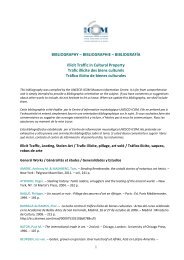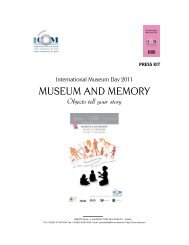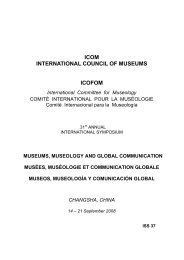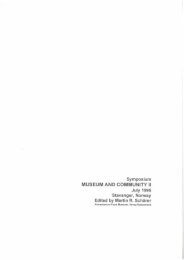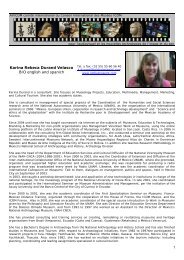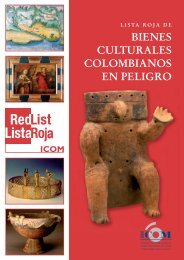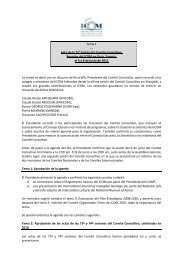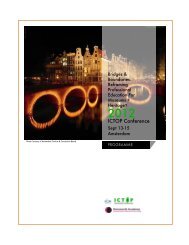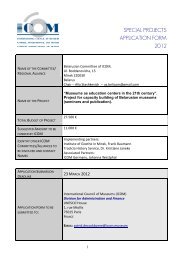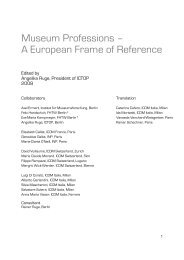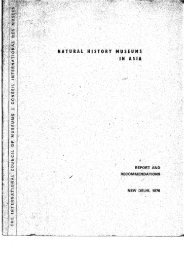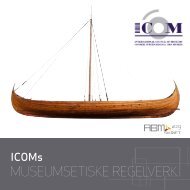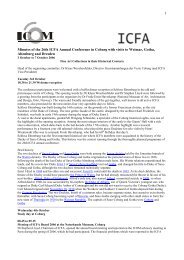Key Concepts of Museology - ICOM
Key Concepts of Museology - ICOM
Key Concepts of Museology - ICOM
You also want an ePaper? Increase the reach of your titles
YUMPU automatically turns print PDFs into web optimized ePapers that Google loves.
76<br />
heterogeneous groups <strong>of</strong> people (the<br />
society <strong>of</strong> this country, bourgeois<br />
society). More precisely, the term<br />
community, regularly used in Anglo-<br />
American countries, does not have<br />
a true equivalent in French since it<br />
represents “A collection <strong>of</strong> constituents<br />
or stakeholders 1) audiences,<br />
2) scholars, 3) other public interpreters,<br />
e.g. Press, interpretative<br />
artists, 4) program providers – arts<br />
groups, etc, 5) repositories, including<br />
libraries, preservation agencies,<br />
museums” (American Association <strong>of</strong><br />
Museums, 2002). The term is translated<br />
in French either by collectivité or<br />
population locale or communauté (in<br />
a restricted sense), or also by milieu<br />
pr<strong>of</strong>essionel.<br />
3. Two types <strong>of</strong> museums– social<br />
museums and community museums –<br />
have been developed in recent decades<br />
in order to emphasise the specifi c<br />
connection that these museums wish<br />
to build with their public. These<br />
museums, traditionally ethnographic<br />
museums, present themselves<br />
as establishments which have strong<br />
ties with their public, who is at the<br />
centre <strong>of</strong> their work. Although the<br />
nature <strong>of</strong> their respective objectives<br />
is similar, their management style<br />
differs, as does their relation with<br />
the public. The term social museums<br />
includes “museums which share the<br />
same objective: to study the evolution<br />
<strong>of</strong> humanity in its social and<br />
historical components, and to transmit<br />
the staging posts, the points <strong>of</strong><br />
reference, for understanding the<br />
diversity <strong>of</strong> cultures and societies”<br />
(Vaillant, 1993). These objectives<br />
establish the museum as a truly interdisciplinary<br />
space and can produce<br />
exhibitions addressing subjects as<br />
varied as the BSE crisis, immigration,<br />
ecology etc. The operation <strong>of</strong><br />
community museums, which can<br />
be part <strong>of</strong> the movement <strong>of</strong> social<br />
museums, is more directly related<br />
to the social, cultural, pr<strong>of</strong>essional<br />
or geographical group which they<br />
represent and which is meant to sustain<br />
them. Although <strong>of</strong>ten pr<strong>of</strong>essionally<br />
managed, they may also rely on<br />
local initiative alone and the spirit <strong>of</strong><br />
giving. The issues they address touch<br />
directly on the functioning and identity<br />
<strong>of</strong> this community; this is particularly<br />
the case for neighbourhood<br />
museums and ecomuseums.<br />
DERIVATIVES: SOCIAL MUSEUMS, SOCIETY<br />
MUSEUMS.<br />
CORRELATED: COMMUNITY, COMMUNITY<br />
DEVELOPMENT, COMMUNITY MUSEUM, DEVELOPMENT<br />
PROGRAMME, ECOMUSEUM, IDENTITY, LOCAL,<br />
NEIGHBOURHOOD MUSEUM, PUBLIC.



